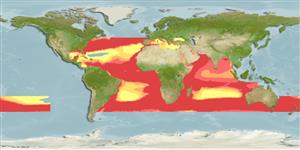Occur in oceanic and coastal waters (Ref. 26340). They are most common along surf beaches and rock headlands in clean, high energy waters, although adults can also be found in estuaries and into brackish water (Ref. 6492). Small fish may be found in shallow coastal waters at least 2 m depth (Ref. 9563), in schools pursuing and attacking small fishes (Ref. 9626). Adults are in loose groups, often attacking shoals of mullets or other fishes and destroying numbers apparently far in excess of feeding requirements (Ref. 9860). Feed on other fish (Ref. 5377), crustaceans and cephalopods (Ref. 47377). Associated with sharks and billfishes (Ref. 26340). Voracious and aggressive (Ref. 9626), reported to bite when handled. Migrate to warmer water during winter and to cooler water in summer (Ref. 9987). Popular game fish (Ref. 6638). Good food fish; marketed mostly fresh (Ref. 9860), but also dried or salted (Ref. 5284), and frozen (Ref. 9987).
出現於大洋性的與沿岸水域.(參考文獻 26340) 他們是最常見的在清澈又生產力高的水域中沿著海灘浪花區與岩石海角, 雖然成魚也能被發現於河口與進入半淡鹹水之內.(參考文獻 6492) 小魚可能被發現於沿岸淺水區至少 2 公尺深 (參考文獻 9563), 成群追逐和攻擊小魚.(參考文獻 9626) 成魚在鬆散的魚群中, 時常攻擊烏魚或者其他的魚的魚群而且破壞超過顯然遠的攝取食物的需求的數字.(參考文獻 9860) 吃其他的魚 (參考文獻 5377) ,甲殼動物與頭足類動物。 (參考文獻 47377) 伴隨著鯊魚與青旗魚了。 (參考文獻 26340) 一個狼吞虎嚥與侵略性種 (參考文獻 9626), 報告咬被觸摸時。 在夏天在冬天期間對較熱的水與對較冷的水域迴游。 (參考文獻 9987) 受歡迎的遊釣魚類.(參考文獻 6638) 好食用魚; 生鮮地 (參考文獻 9860) 大部份在市場上銷售, 也乾燥或鹽醃 (參考文獻 5284), 與冷凍.(參考文獻 9987)
Preferred temperature (Ref.
115969): 8.4 - 27.5, mean 21.1 (based on 1273 cells).
Phylogenetic diversity index (Ref.
82804): PD
50 = 1.5000 [Uniqueness, from 0.5 = low to 2.0 = high].
Bayesian length-weight: a=0.01072 (0.00841 - 0.01366), b=2.97 (2.90 - 3.04), in cm Total Length, based on LWR estimates for this species (Ref.
93245).
營養階層 (Ref.
69278): 4.5 ±0.3 se; based on diet studies.
回復力 (Ref.
120179): 中等的, 族群倍增時間最少 1.4 - 4.4年 (K=0.10-0.2; tm=2; tmax=9; Fec=1 million).
Prior r = 0.67, 95% CL = 0.44 - 1.01, Based on 7 stock assessments.
Fishing Vulnerability (Ref.
59153): Moderate vulnerability (42 of 100).
Climate Vulnerability (Ref.
125649): Moderate to high vulnerability (46 of 100).
